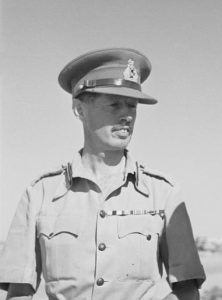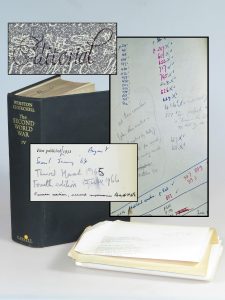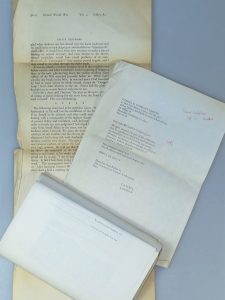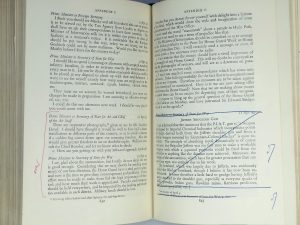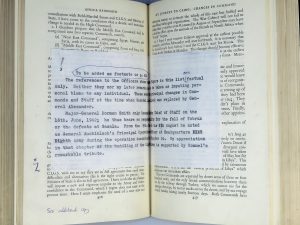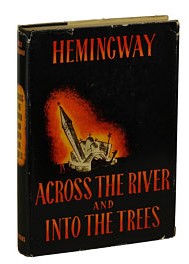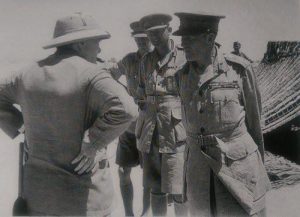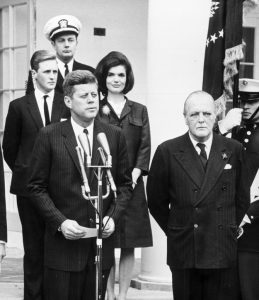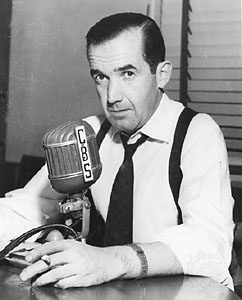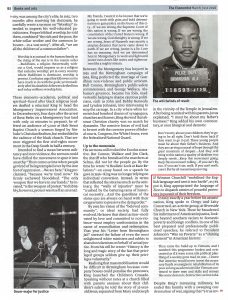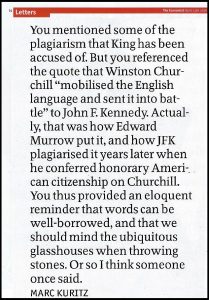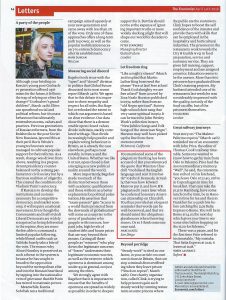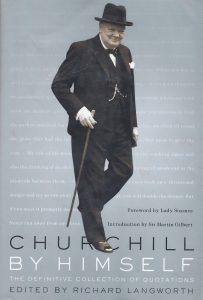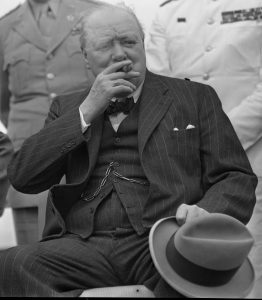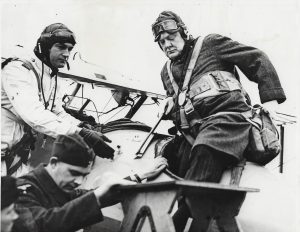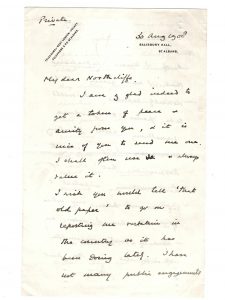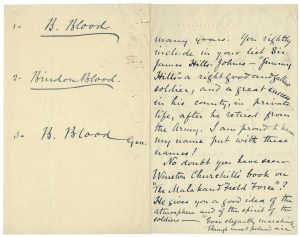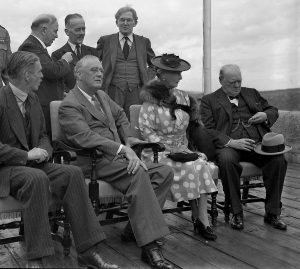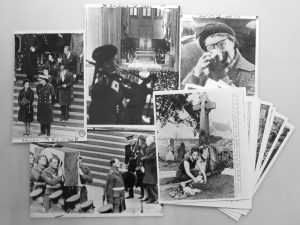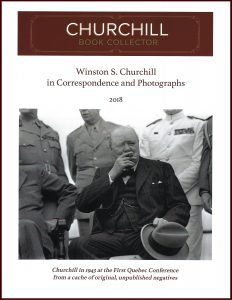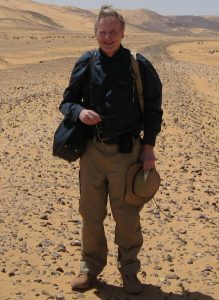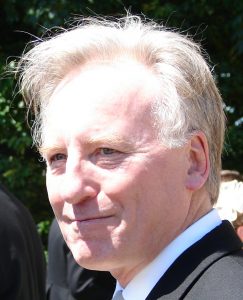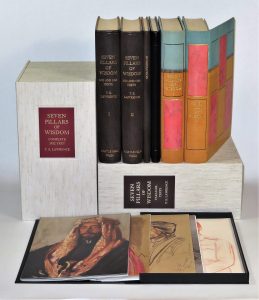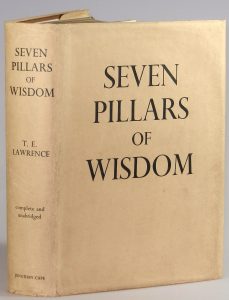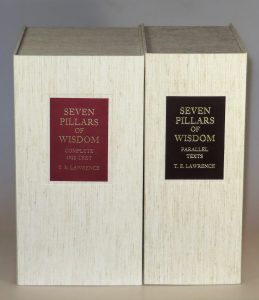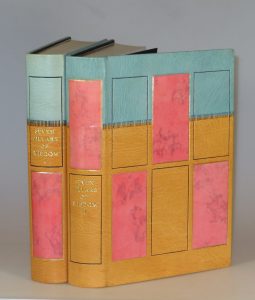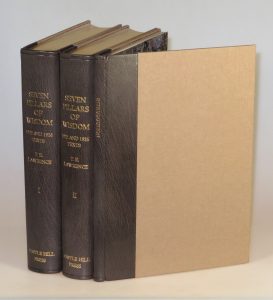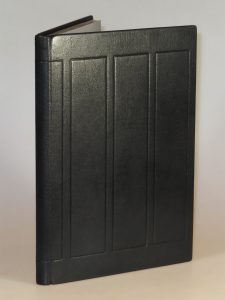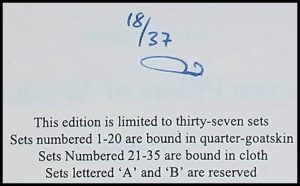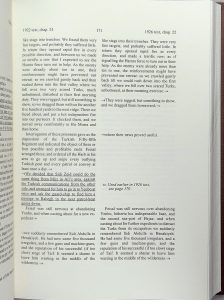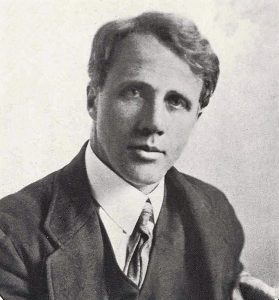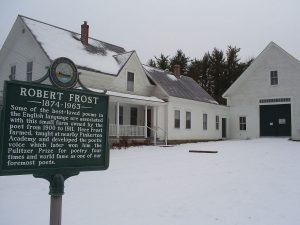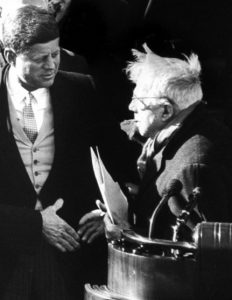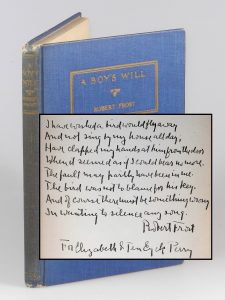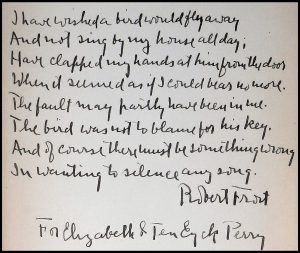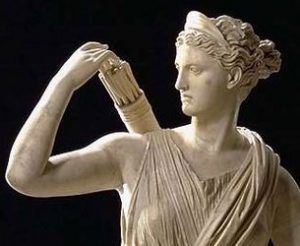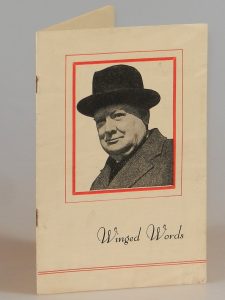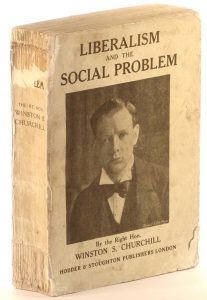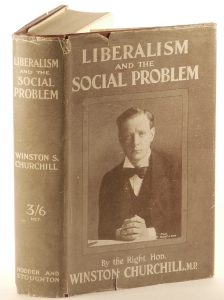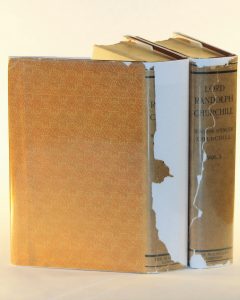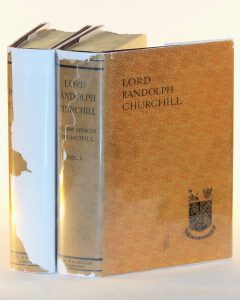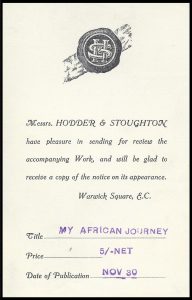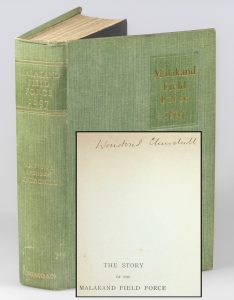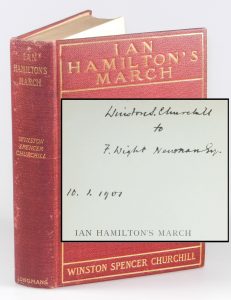The broad sweep of history is something Winston Churchill comprehended and communicated with extraordinary facility. The proverbial “big picture”. Naturally, we value the commanding views of the few great figures who conspicuously shape events. But the voices of the many who are quietly living history are often lost. When we are able to hear them, such voices can impart a more intimate and richly textured human scale.
Which brings me to the subject of this post.
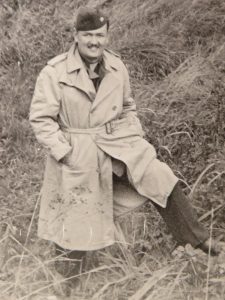 With genuine excitement, we have just catalogued a unique, handmade book in which the writer, photographer, and compiler, Dalton Newfield (1918-1982) chronicled – in words and photos – the impromptu, unsanctioned, and rather remarkable European tour by jeep in the days immediately following the surrender of Japan in August 1945.
With genuine excitement, we have just catalogued a unique, handmade book in which the writer, photographer, and compiler, Dalton Newfield (1918-1982) chronicled – in words and photos – the impromptu, unsanctioned, and rather remarkable European tour by jeep in the days immediately following the surrender of Japan in August 1945.
It so happens that Dalton Newfield was later the world’s first Churchill-specialist bookseller. He also became the senior editor of the International Churchill Society’s journal, Finest Hour. But while this earns him our enduring respect and appreciation, it has little to do with why we are writing about Dalton today.
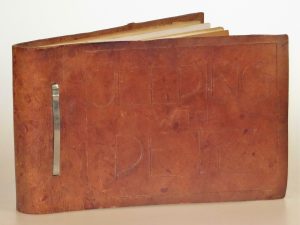 Dalton’s unpublished, previously unknown, and strikingly interesting little book, Jeeping with ‘Pete’ is 67 pages of often dense typed narrative illustrated with 87 original photos and 13 European postcards of the era. It is bound in thick brown leather, which Dalton meticulously incised with the title on the front cover and bound with a metal strip.
Dalton’s unpublished, previously unknown, and strikingly interesting little book, Jeeping with ‘Pete’ is 67 pages of often dense typed narrative illustrated with 87 original photos and 13 European postcards of the era. It is bound in thick brown leather, which Dalton meticulously incised with the title on the front cover and bound with a metal strip.
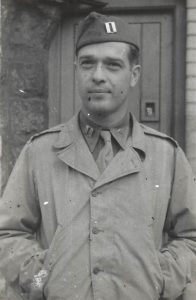 During the Second World War, Dalton Newfield served in the U.S. Army Signal Corps. After the Japanese surrendered in August 1945, Dalton decided to see Europe for himself in the war’s immediate aftermath. Newfield took with him a lighter he engraved for every country he visited and the title’s eponymous “Pete” – his friend Peter Luppen. His book records what he saw and how he saw it during an epic and improbable road trip.
During the Second World War, Dalton Newfield served in the U.S. Army Signal Corps. After the Japanese surrendered in August 1945, Dalton decided to see Europe for himself in the war’s immediate aftermath. Newfield took with him a lighter he engraved for every country he visited and the title’s eponymous “Pete” – his friend Peter Luppen. His book records what he saw and how he saw it during an epic and improbable road trip.
Dalton’s prose is neither polished nor deliberatively philosophical, evidently typed as he went along and peppered with spelling, typing, and grammatical errors. But there is pith and thoughtful observation evident in both his words and his photographs. Dalton’s photography is better than amateur and can be truly moving.
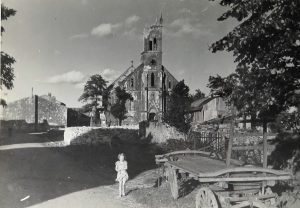 His images capture a diverse range of subjects. Nuns in Paris. Turbaned Moroccan soldiers posing with lederhosen-clad children in Austria. Men excavating the rubble of a bombed town. Allied edicts posted along the German border. Abandoned vehicles on the Autobahn. Boats laying quietly out of the water in a fishing port. A disheveled little girl, small and barefoot in the bright sun with a shadowed stone wall and a darkened, bomb-damaged church in the background.
His images capture a diverse range of subjects. Nuns in Paris. Turbaned Moroccan soldiers posing with lederhosen-clad children in Austria. Men excavating the rubble of a bombed town. Allied edicts posted along the German border. Abandoned vehicles on the Autobahn. Boats laying quietly out of the water in a fishing port. A disheveled little girl, small and barefoot in the bright sun with a shadowed stone wall and a darkened, bomb-damaged church in the background.
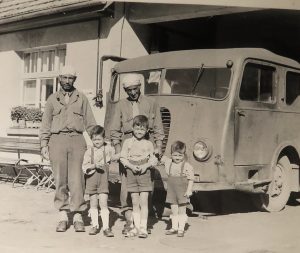 This was neither an official nor a sanctioned adventure. As Dalton observed: “Our orders are a bit questionable, as mine only carry me to Paris definitely and Petes don’t carry him to any particular place.” Dalton explains “…we talked over our choice between going like hell and seeing a little bit of a lot of different places, and taking it easy and seeing a lot of a few… we chose the former…” Dalton and Pete made a remarkable dash of a trek, crossing through France, Belgium, Luxembourg, Germany, Austria, Switzerland, and Italy.
This was neither an official nor a sanctioned adventure. As Dalton observed: “Our orders are a bit questionable, as mine only carry me to Paris definitely and Petes don’t carry him to any particular place.” Dalton explains “…we talked over our choice between going like hell and seeing a little bit of a lot of different places, and taking it easy and seeing a lot of a few… we chose the former…” Dalton and Pete made a remarkable dash of a trek, crossing through France, Belgium, Luxembourg, Germany, Austria, Switzerland, and Italy.
Starting off in Cherbourg, France on 19 August 1945, the duo began their journey south to Paris. Along the way Dalton gives an affecting depiction of the ways in which life in small towns in France simultaneously showed the scars of the War’s technological assault and retained their nearly pre-industrial ways of life. Phot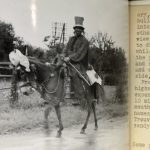 ographs depict a liberation parade with revelers riding donkeys and floats pulled by horses. A pair of fisherman bait their lines and coil them into baskets. A town crier beats a drum to summon townsfolk, before delivering news.
ographs depict a liberation parade with revelers riding donkeys and floats pulled by horses. A pair of fisherman bait their lines and coil them into baskets. A town crier beats a drum to summon townsfolk, before delivering news. 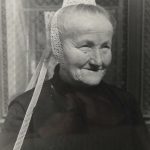
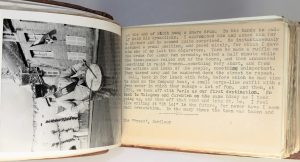 “…at the very end of the main street we found the town crier. He was very shabbily dressed in remnants of what may have been great glory in the past. Perhaps in peacetime he will recoup. He had on a faded blue shirt and old, dirty, black trousers. On his head a jaunty, if dusty, pillbox hat. Across his chest a leather strap… at the end of which hung a snare drum… I approached him and asked him for a picture. He instantaneously assumed a proud position and posed nicely, for which I gave him one of my last two cigarettes. Then he made a ruffle on the drums for about ten seconds, waited a half minute while the townspeople rolled out of the doors, and then announced something in rapid French…”
“…at the very end of the main street we found the town crier. He was very shabbily dressed in remnants of what may have been great glory in the past. Perhaps in peacetime he will recoup. He had on a faded blue shirt and old, dirty, black trousers. On his head a jaunty, if dusty, pillbox hat. Across his chest a leather strap… at the end of which hung a snare drum… I approached him and asked him for a picture. He instantaneously assumed a proud position and posed nicely, for which I gave him one of my last two cigarettes. Then he made a ruffle on the drums for about ten seconds, waited a half minute while the townspeople rolled out of the doors, and then announced something in rapid French…”
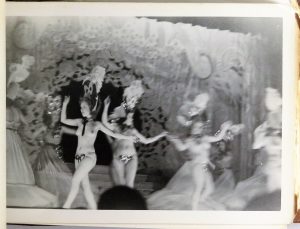 Dalton described post-liberation Parisian diversions; Dalton and Pete navigated a black market currency exchange in a “disreputable café”, attended a burlesque show in Pigalle (capturing two images of the topless and feathered dancers), saw an Agatha Christie play (“Ten Little Niggers”), and witnessed a fire dancer at an Officer’s Club.
Dalton described post-liberation Parisian diversions; Dalton and Pete navigated a black market currency exchange in a “disreputable café”, attended a burlesque show in Pigalle (capturing two images of the topless and feathered dancers), saw an Agatha Christie play (“Ten Little Niggers”), and witnessed a fire dancer at an Officer’s Club.
Continuing east, Dalton paints a vivid picture of the devastation left behind by the war. “Following the coast line we began to see names that we had seen many times in the papers after D Day. Trouville, Villerville, Deauville.” He becomes a discerning connoisseur of carnage: “There are differences in wreckage. The wreckage of bombing seems almost gentler than that by shelling… You can see that Caen was shelled.”
While exploring a bombed church in Alsace-Lorraine, Dalton and Pete encountered a German-speaking priest, “a burly character with a days growth of beard too many…”
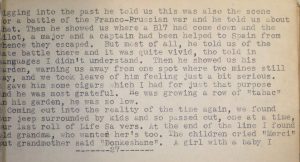 “… he told us all about the battle there… He took us into his backyard and showed us the foxholes the Americans had used. I felt quite humble as he picked up some cartridge cases, cases that had been fired against Germans. A gas mask lay by the field a Sherman tank lay blasted… Digging into the past he told us this was also the scene for a battle of the Franco-Prussian war… Then he showed us where a B17 had come down… But most of all, he told us of the late battle there and it was quite vivid… he showed us his garden, warning us away from one spot where two mines still lay… I gave him some cigars… and he was most grateful. He was growing a row of “tabac” in the garden, he was so low. Coming out into the reality of the time again, we found our jeep surrounded by kids and so passed out, one at a time, our last roll of Life Savers. At the end of the line I found old grandma, who wanted her’s too. The children cried “Merci” but grandmother said “Donkeshane”… we climbed into the jeep and slowly drove away… caught between two countries whose fate has been one war after another.”
“… he told us all about the battle there… He took us into his backyard and showed us the foxholes the Americans had used. I felt quite humble as he picked up some cartridge cases, cases that had been fired against Germans. A gas mask lay by the field a Sherman tank lay blasted… Digging into the past he told us this was also the scene for a battle of the Franco-Prussian war… Then he showed us where a B17 had come down… But most of all, he told us of the late battle there and it was quite vivid… he showed us his garden, warning us away from one spot where two mines still lay… I gave him some cigars… and he was most grateful. He was growing a row of “tabac” in the garden, he was so low. Coming out into the reality of the time again, we found our jeep surrounded by kids and so passed out, one at a time, our last roll of Life Savers. At the end of the line I found old grandma, who wanted her’s too. The children cried “Merci” but grandmother said “Donkeshane”… we climbed into the jeep and slowly drove away… caught between two countries whose fate has been one war after another.”
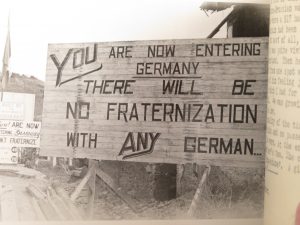 They continued through Belgium and Luxembourg. Dalton’s comments show him curious and observant, but also clearly marked by the bitter sentiments of a soldier who has lost time, hearth, and comrades to an unforgiven foe. Passing into Germany Dalton notes “we didn’t pause here, and to celebrate the new country for my lighter, I merely spat out the window.” In Germany, Dalton observed the devastation one would expect to find in August 1945: “The route from Homburg to Ludwigshaved is so littered with the wreckage of armored armies that it is nigh indescribable. Almost bumper to bumper, and in many places several deep, the carcases of trucks, cars, and tanks line the way.” Later, observing “burned-out tanks, Bren gun carriers, trucks, etc., all along way” Dalton says – perhaps inadvertently laconic and symbolic – “Occasionally they had been gathered into piles for salvage, but for the most part they lay as they died. The farmers carefully plowed around them.
They continued through Belgium and Luxembourg. Dalton’s comments show him curious and observant, but also clearly marked by the bitter sentiments of a soldier who has lost time, hearth, and comrades to an unforgiven foe. Passing into Germany Dalton notes “we didn’t pause here, and to celebrate the new country for my lighter, I merely spat out the window.” In Germany, Dalton observed the devastation one would expect to find in August 1945: “The route from Homburg to Ludwigshaved is so littered with the wreckage of armored armies that it is nigh indescribable. Almost bumper to bumper, and in many places several deep, the carcases of trucks, cars, and tanks line the way.” Later, observing “burned-out tanks, Bren gun carriers, trucks, etc., all along way” Dalton says – perhaps inadvertently laconic and symbolic – “Occasionally they had been gathered into piles for salvage, but for the most part they lay as they died. The farmers carefully plowed around them.
In Austria, while changing a particularly stubborn flat with help from the locals, Dalton observed: “I had a good chance to talk to these people. We talked, of course, mostly about the war, and I found that what others are finding is true: it is always someone else to blame, never the person you are talking to. The Fraulein had lost a brother at Stalingrad and her fiancée in France and was quite sorry. Her father she had not heard from since March. I found myself sympathizing with her until I caught myself and started questioning her about Hitler.”
A more philosophically unforgiving Dalton also observes of the Austrians: “They had only the choice of accepting or being killed or put in a concentration camp, so that they made the best of a bad thing… I left but in leaving thought: “Is life so dear or peace so sweet that it must be purchased at the price of chains and slavery?”
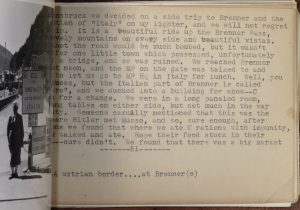 Where there are glints of sympathy for the volk, there is none for those who led them to war. Crossing into Italy via the Brenner Pass, Dalton noted: “Someone casually mentioned that this was the room where Hitler met Musso, and so, sure enough, after questions we found that where we ate C rations with impunity, H and M talked and ate. Hope their food stuck in their craws – ours didn’t.”
Where there are glints of sympathy for the volk, there is none for those who led them to war. Crossing into Italy via the Brenner Pass, Dalton noted: “Someone casually mentioned that this was the room where Hitler met Musso, and so, sure enough, after questions we found that where we ate C rations with impunity, H and M talked and ate. Hope their food stuck in their craws – ours didn’t.”
Despite the hardened perspectives that understandably informed and colored what Dalton saw, it is clear from his images and prose that the journey was affecting. In the final pages of his narrative, Dalton enigmatically writes: “…so good that we are thinking – just thinking – that maybe – well, we shall see.”
The book opens with Dalton’s carefully printed and signed title page and dedication:
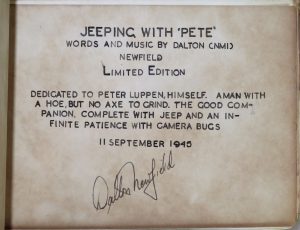 JEEPING WITH ‘PETE’
JEEPING WITH ‘PETE’
WORDS AND MUSIC BY DALTON (NMI)
NEWFIELD
LIMITED EDITION
DEDICATED TO PETER LUPPEN, HIMSELF. A MAN WITH
A HOE, BUT NO AXE TO GRIND. THE GOOD COM-
PANION, COMPLETE WITH JEEP AND AN IN-
FINITE PATIENCE WITH CAMERA BUGS
11 SEPTEMBER 1945
Below the date is Dalton’s autograph.
At the end of Dalton’s narrative, below the word “FIN”, Dalton typed a postscript:
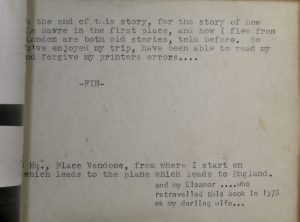 “From ATC Hq., Place Vendrome, from where I start on the bus which leads to the plane which leads to England.
“From ATC Hq., Place Vendrome, from where I start on the bus which leads to the plane which leads to England.
Just below that postscript, a second postscript, in different type evidently added later:
“and my Eleanor ….who
retravelled this book in 1978
as my darling wife…”
Dalton Newfield took from wartime Europe not only an abiding respect for Churchill, but also an English bride. The final page of the book is a holograph postscript in the hand Dalton’s wife, Eleanor:
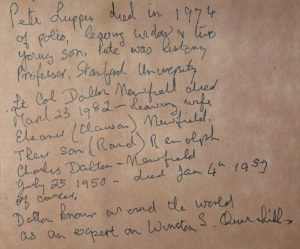 Peter Luppen died in 1974
Peter Luppen died in 1974
of polio, leaving widow & two
young son. Pete was history
Professor, Stanford University.
Lt Col Dalton Dalton Newfield died
March 23 1982 – leaving wife
Eleanor (Clauson) Newfield.
Their son (Rand) Randolph
Charles Dalton-Newfield
July 25 1950 – died Jan 4th1959
of cancer.
Dalton known around the world
as an expert on Winston S. Churchill.
We also include two additional photographs, of Dalton Newfield and Peter Luppen, which were found laid into the book, as well as eleven pages of what appears to be a later, unfinished, type-written attempt by Newfield to fictionalize the narrative.
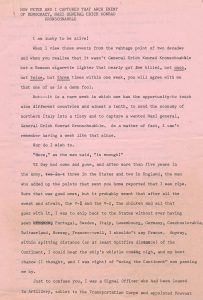 It has been a pleasure and a privilege for us to review, relive, and relate the singular perspective and experiences compiled in this singular little book. We look forward to relinquishing “Jeeping with Pete” to the stewardship of a new collector, ensuring the preservation and continued appreciation of the vivid and intimate vignettes therein.
It has been a pleasure and a privilege for us to review, relive, and relate the singular perspective and experiences compiled in this singular little book. We look forward to relinquishing “Jeeping with Pete” to the stewardship of a new collector, ensuring the preservation and continued appreciation of the vivid and intimate vignettes therein.
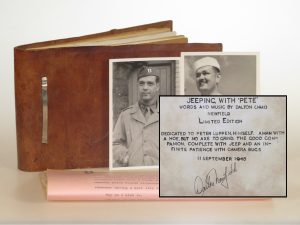
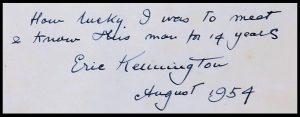 Today, a first trade edition of Seven Pillars of Wisdomrendered special by a poignant inscription by Eric Kennington, the man who created thirty-one of the illustrations within its pages. Inked in blue in four lines on the half title, Kennington wrote: “How lucky I was to meet | & know this man for 14 years | Eric Kennington | August 1954”.
Today, a first trade edition of Seven Pillars of Wisdomrendered special by a poignant inscription by Eric Kennington, the man who created thirty-one of the illustrations within its pages. Inked in blue in four lines on the half title, Kennington wrote: “How lucky I was to meet | & know this man for 14 years | Eric Kennington | August 1954”.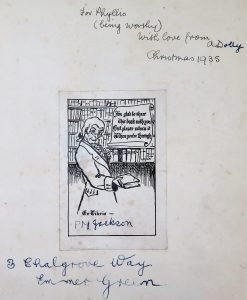 A gift inscription “For Phyllis” dated “Christmas 1935” is inked on the front free endpaper above the illustrated book plate of “PM Jackson”.
A gift inscription “For Phyllis” dated “Christmas 1935” is inked on the front free endpaper above the illustrated book plate of “PM Jackson”.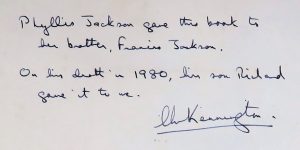 A five-line inked notation on the front free endpaper verso that appears to be signed by Christopher Kennington (Eric Kennington’s son) reads: “Phyllis Jackson gave this book to | her brother, Francis Jackson. | On his death in 1980, his son Richard | gave it to me.”
A five-line inked notation on the front free endpaper verso that appears to be signed by Christopher Kennington (Eric Kennington’s son) reads: “Phyllis Jackson gave this book to | her brother, Francis Jackson. | On his death in 1980, his son Richard | gave it to me.”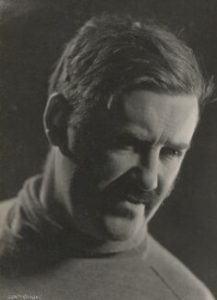 Eric Henri Kennington (1888-1960) was known as a painter, print maker, and sculptor and, most notably, as “a born painter of the nameless heroes of the rank and file” whom he portrayed during both the First and Second World War.
Eric Henri Kennington (1888-1960) was known as a painter, print maker, and sculptor and, most notably, as “a born painter of the nameless heroes of the rank and file” whom he portrayed during both the First and Second World War.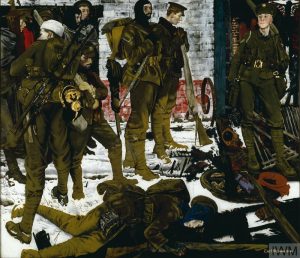 Badly wounded on the Western Front in 1915, during his convalescence he produced The Kensingtons at Laventie, a portrait of a group of infantrymen. When exhibited in the spring of 1916 its portrayal of exhausted soldiers created a sensation. Kennington finished the war employed as a war artist by the Ministry of Information. After the war, he met T. E. Lawrence at an exhibition of Kennington’s war art.
Badly wounded on the Western Front in 1915, during his convalescence he produced The Kensingtons at Laventie, a portrait of a group of infantrymen. When exhibited in the spring of 1916 its portrayal of exhausted soldiers created a sensation. Kennington finished the war employed as a war artist by the Ministry of Information. After the war, he met T. E. Lawrence at an exhibition of Kennington’s war art.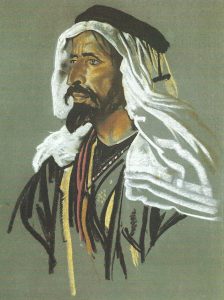 In 1921, Kennington traveled to the Middle East with Lawrence where, Lawrence approvingly wrote of his work, “instinctively he drew the men of the desert.” Kennington served as art editor for Lawrence’s legendary 1926 Subscribers’ Edition of Seven Pillars of Wisdomand produced many of the drawings therein.
In 1921, Kennington traveled to the Middle East with Lawrence where, Lawrence approvingly wrote of his work, “instinctively he drew the men of the desert.” Kennington served as art editor for Lawrence’s legendary 1926 Subscribers’ Edition of Seven Pillars of Wisdomand produced many of the drawings therein.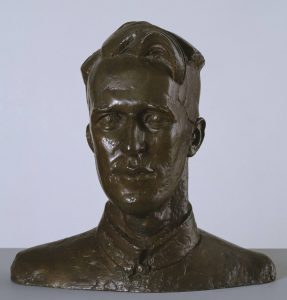 That same year he produced a bust of Lawrence – an image of which is the frontispiece of this book. On 15 February 1927, Lawrence wrote to Kennington praising the bust as “magnificent”. Lawrence said “It represents not me, but my top-moments, those few seconds in which I succeed in thinking myself right out of things.” In 1935, Kennington served as one of Lawrence’s pallbearers.
That same year he produced a bust of Lawrence – an image of which is the frontispiece of this book. On 15 February 1927, Lawrence wrote to Kennington praising the bust as “magnificent”. Lawrence said “It represents not me, but my top-moments, those few seconds in which I succeed in thinking myself right out of things.” In 1935, Kennington served as one of Lawrence’s pallbearers.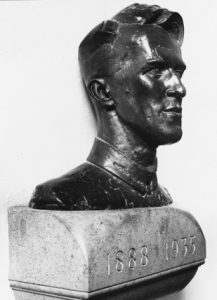 In 1936 his second, memorial bust of Lawrence was installed in the crypt of St. Paul’s Cathedral. Kennington was again an official war artist for the British government during the Second World War (Ministry of Information and Air Ministry), producing a large number of portraits of individual soldiers in addition to military scenes. Kennington died a member of the Royal Academy six years after writing the inscription in this book.
In 1936 his second, memorial bust of Lawrence was installed in the crypt of St. Paul’s Cathedral. Kennington was again an official war artist for the British government during the Second World War (Ministry of Information and Air Ministry), producing a large number of portraits of individual soldiers in addition to military scenes. Kennington died a member of the Royal Academy six years after writing the inscription in this book.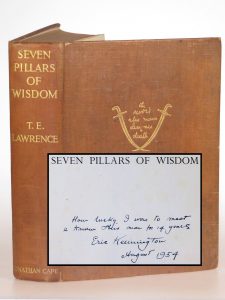 It was only in the summer of 1935, in the weeks following Lawrence’s death, that the text of the Subscribers’ Edition text was finally published for circulation to the general public in the form of a British first trade edition. This copy inscribed by Kennington is the first printing of this British first trade edition. Condition is good, showing the aesthetic flaws of age and wear, but sound. The khaki cloth binding is square and tight with wear to extremities, overall soiling and staining, and considerable scuffing to the rear cover. The contents are clean with toning to the page edges. A tiny Colchester bookseller sticker is affixed to the lower rear pastedown.
It was only in the summer of 1935, in the weeks following Lawrence’s death, that the text of the Subscribers’ Edition text was finally published for circulation to the general public in the form of a British first trade edition. This copy inscribed by Kennington is the first printing of this British first trade edition. Condition is good, showing the aesthetic flaws of age and wear, but sound. The khaki cloth binding is square and tight with wear to extremities, overall soiling and staining, and considerable scuffing to the rear cover. The contents are clean with toning to the page edges. A tiny Colchester bookseller sticker is affixed to the lower rear pastedown.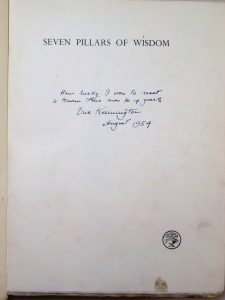 Look for this and dozens of other signed or inscribed items in our “Extra Ink” catalogue late in 2018!
Look for this and dozens of other signed or inscribed items in our “Extra Ink” catalogue late in 2018!
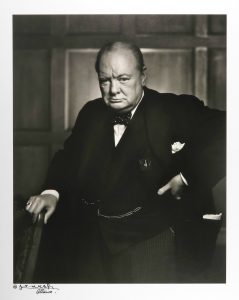
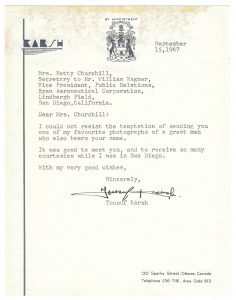 The photo itself is signed by Karsh in black in two lines on the lower left margin of the photo “© Y Karsh | Ottawa.” But in addition to Karsh’s signature, this photo comes with a presentation letter from Karsh typed on his Ottawa studio stationery and signed “Yousuf Karsh.” The letter is dated “September 15, 1967” and addressed: “Mrs. Betty Churchill, Secretary to Mr. William Wagner, Vice President, Public Relations, Ryan Aeronautical Corporation, Lindbergh Field, San Diego, California.”
The photo itself is signed by Karsh in black in two lines on the lower left margin of the photo “© Y Karsh | Ottawa.” But in addition to Karsh’s signature, this photo comes with a presentation letter from Karsh typed on his Ottawa studio stationery and signed “Yousuf Karsh.” The letter is dated “September 15, 1967” and addressed: “Mrs. Betty Churchill, Secretary to Mr. William Wagner, Vice President, Public Relations, Ryan Aeronautical Corporation, Lindbergh Field, San Diego, California.”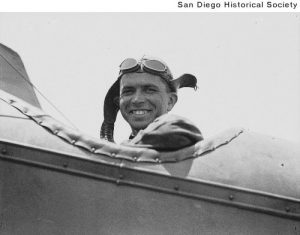 Tubal Claude Ryan (1898-1982) bought his first airplane, a Curtiss JN-4 Jenny, in San Diego in 1922, and began his aeronautical enterprises by charging for rides. By the late 1920s his aviation ventures included the nation’s first year-round regularly scheduled daily airline passenger service. In 1927, Ryan’s namesake company was tasked with building a single-engine plane that would be called The Spirit of St. Louis for a fellow named Charles Lindbergh.
Tubal Claude Ryan (1898-1982) bought his first airplane, a Curtiss JN-4 Jenny, in San Diego in 1922, and began his aeronautical enterprises by charging for rides. By the late 1920s his aviation ventures included the nation’s first year-round regularly scheduled daily airline passenger service. In 1927, Ryan’s namesake company was tasked with building a single-engine plane that would be called The Spirit of St. Louis for a fellow named Charles Lindbergh.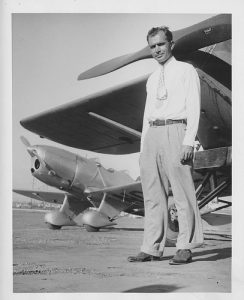 After Lindberg’s historic solo flight, in 1928 Ryan founded The Ryan Aeronautical Corporation. This company, among many accomplishments, built the preeminent trainer aircraft used though the Second World War, the first jet-plus-propeller aircraft for the Navy, and the first successful vertical takeoff and landing aircraft, as well as pioneering remotely piloted vehicles and jet drones, Doppler systems, and lunar landing radar.
After Lindberg’s historic solo flight, in 1928 Ryan founded The Ryan Aeronautical Corporation. This company, among many accomplishments, built the preeminent trainer aircraft used though the Second World War, the first jet-plus-propeller aircraft for the Navy, and the first successful vertical takeoff and landing aircraft, as well as pioneering remotely piloted vehicles and jet drones, Doppler systems, and lunar landing radar.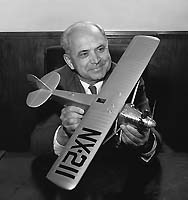 In 1969, just a few years after this photograph was signed and presented by Karsh, Ryan Aeronautical became Teledyne Ryan, a subsidiary of Teledyne, at an acquisition price of $128 million. Teledyne Ryan became, in turn, part of Northrop Grumman in 1999.
In 1969, just a few years after this photograph was signed and presented by Karsh, Ryan Aeronautical became Teledyne Ryan, a subsidiary of Teledyne, at an acquisition price of $128 million. Teledyne Ryan became, in turn, part of Northrop Grumman in 1999.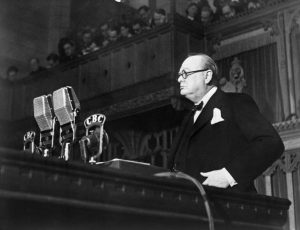 Churchill’s speech of December 26, 1941 to a joint session of the U.S. Congress was sober, resolved, and eloquently defiant, but of course also featured the sparkle of Churchillian wit, which was irrepressible even in the dark hours of the war: “I cannot help reflecting that if my father had been American and my mother British, instead of the other way around, I might have got here on my own.” His speech was also an important personal introduction to the elected leaders he needed to embrace the alliance so vital to his nation. A few days later, in his famous “Some chicken, some neck!” speech of December 30 to both houses of the Canadian Parliament, Churchill was characteristically defiant: “When I warned them that Britain would fight alone whatever they did, their generals told their Prime Minister and his divided Cabinet ‘In three weeks England will have her neck wrung like a chicken.’ Some chicken; some neck.”
Churchill’s speech of December 26, 1941 to a joint session of the U.S. Congress was sober, resolved, and eloquently defiant, but of course also featured the sparkle of Churchillian wit, which was irrepressible even in the dark hours of the war: “I cannot help reflecting that if my father had been American and my mother British, instead of the other way around, I might have got here on my own.” His speech was also an important personal introduction to the elected leaders he needed to embrace the alliance so vital to his nation. A few days later, in his famous “Some chicken, some neck!” speech of December 30 to both houses of the Canadian Parliament, Churchill was characteristically defiant: “When I warned them that Britain would fight alone whatever they did, their generals told their Prime Minister and his divided Cabinet ‘In three weeks England will have her neck wrung like a chicken.’ Some chicken; some neck.”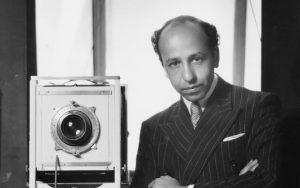 Born in Armenian Turkey, Karsh had fled on foot with his family to Syria before immigrating to Canada in 1924 as a refugee. After apprenticing with the celebrity portrait photographer John H. Garo, Karsh moved to Ottawa, where he opened a portrait studio with the intent of photographing “people of consequence.” His breakthrough came in 1936 when he photographed the meeting between U.S. President
Born in Armenian Turkey, Karsh had fled on foot with his family to Syria before immigrating to Canada in 1924 as a refugee. After apprenticing with the celebrity portrait photographer John H. Garo, Karsh moved to Ottawa, where he opened a portrait studio with the intent of photographing “people of consequence.” His breakthrough came in 1936 when he photographed the meeting between U.S. President 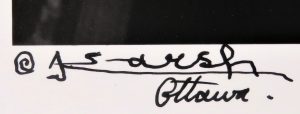 Printing date is established by the letter and the fact that Karsh stopped signing his photos with “Ottawa” in the late 1960s. The image verso bears the studio stamp of Karsh’s Ottawa studio reading “COPYRIGHT | the following copyright must be used | © Karsh, Ottawa” as well as a penciled “P of G” notation referring to the image’s inclusion in Karsh’s book Portraits of Greatness(1959).
Printing date is established by the letter and the fact that Karsh stopped signing his photos with “Ottawa” in the late 1960s. The image verso bears the studio stamp of Karsh’s Ottawa studio reading “COPYRIGHT | the following copyright must be used | © Karsh, Ottawa” as well as a penciled “P of G” notation referring to the image’s inclusion in Karsh’s book Portraits of Greatness(1959).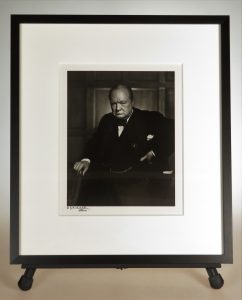
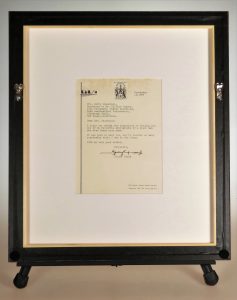 We deliberately chose not to frame in the conventional manner, with the photo matted and framed beside the letter. The photo is simply too striking an image to warrant the aesthetic distraction of the letter right beside it. Instead, we commissioned a custom, double-sided frame using museum quality, archival materials. The solid walnut frame is stained dark black with a thick 8-ply rag board mat for added depth and richness and is glazed with UV filtering acrylic. On the reverse the letter has also been matted and glazed. The framed piece measures 17.375 x 15.375 inches (44.1 x 39 cm).
We deliberately chose not to frame in the conventional manner, with the photo matted and framed beside the letter. The photo is simply too striking an image to warrant the aesthetic distraction of the letter right beside it. Instead, we commissioned a custom, double-sided frame using museum quality, archival materials. The solid walnut frame is stained dark black with a thick 8-ply rag board mat for added depth and richness and is glazed with UV filtering acrylic. On the reverse the letter has also been matted and glazed. The framed piece measures 17.375 x 15.375 inches (44.1 x 39 cm).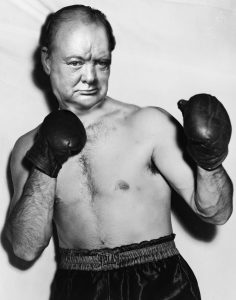
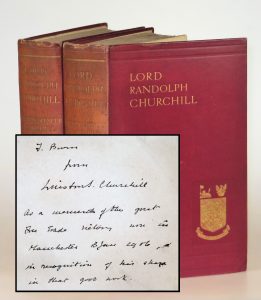
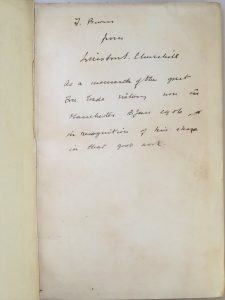
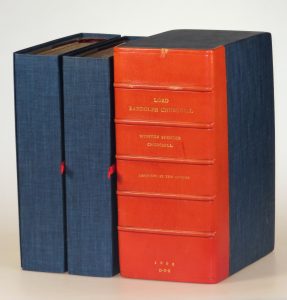
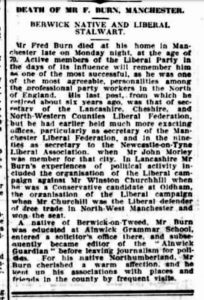
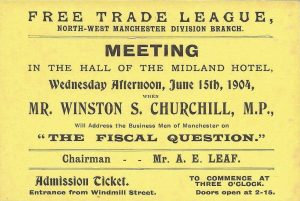
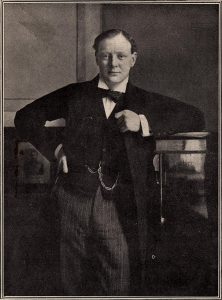 On 31 May 1904 Churchill left his father’s Conservative Party, crossing the aisle to become a Liberal, beginning a dynamic chapter in his political career that saw him champion progressive causes and branded a traitor to his class. On 2 January 1906 Churchill published his two-volume biography of his father. Immediately thereafter, he campaigned for eight days in North-West Manchester, hoping to win his first election as a Liberal.
On 31 May 1904 Churchill left his father’s Conservative Party, crossing the aisle to become a Liberal, beginning a dynamic chapter in his political career that saw him champion progressive causes and branded a traitor to his class. On 2 January 1906 Churchill published his two-volume biography of his father. Immediately thereafter, he campaigned for eight days in North-West Manchester, hoping to win his first election as a Liberal.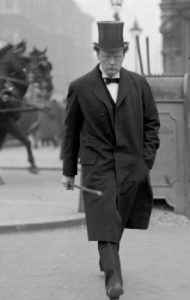 Churchill’s defection from the Conservative Party was much on the minds of the voters. His father’s history was much on his own mind. To the charge of being a political turncoat, Churchill replied: “I admit I have changed my Party. I don’t deny it. I am proud of it. When I think of all of the labours Lord Randolph Churchill gave to the fortunes of the Conservative Party and the ungrateful way he was treated by them when they obtained the power they would never have had but for him, I am delighted that circumstances have enabled me to break with them while I am still young, and still have the best energies of my life to give to the popular cause.”
Churchill’s defection from the Conservative Party was much on the minds of the voters. His father’s history was much on his own mind. To the charge of being a political turncoat, Churchill replied: “I admit I have changed my Party. I don’t deny it. I am proud of it. When I think of all of the labours Lord Randolph Churchill gave to the fortunes of the Conservative Party and the ungrateful way he was treated by them when they obtained the power they would never have had but for him, I am delighted that circumstances have enabled me to break with them while I am still young, and still have the best energies of my life to give to the popular cause.”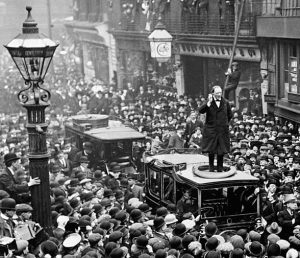 North-West Manchester would prove a brief and fraught interlude in Churchill’s six-decade Parliamentary career, his shortest relationship among the five constituencies he ultimately held. In 1908 when Churchill was appointed to the Cabinet as President of the Board of Trade, custom required that he submit to re-election. His by-election became a test of confidence in the Liberal government. Forced to defend the Government’s policies, targeted by vengeful Conservatives, and hounded on the hustings by Suffragettes, Churchill was narrowly defeated by the Conservative candidate.
North-West Manchester would prove a brief and fraught interlude in Churchill’s six-decade Parliamentary career, his shortest relationship among the five constituencies he ultimately held. In 1908 when Churchill was appointed to the Cabinet as President of the Board of Trade, custom required that he submit to re-election. His by-election became a test of confidence in the Liberal government. Forced to defend the Government’s policies, targeted by vengeful Conservatives, and hounded on the hustings by Suffragettes, Churchill was narrowly defeated by the Conservative candidate.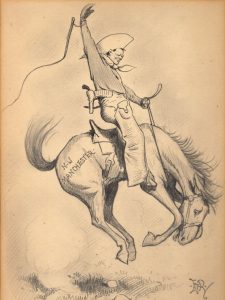 Nonetheless, the 13 January 1906 election and Churchill’s brief time as M.P. for North-West Manchester made all things possible for him. At 31 years old, “Churchill was now a Junior Minister in a Government furnished with far greater authority than it had expected.” Disraeli’s biographer wrote to congratulate Churchill “both on his book and the beginning of his official career”.
Nonetheless, the 13 January 1906 election and Churchill’s brief time as M.P. for North-West Manchester made all things possible for him. At 31 years old, “Churchill was now a Junior Minister in a Government furnished with far greater authority than it had expected.” Disraeli’s biographer wrote to congratulate Churchill “both on his book and the beginning of his official career”.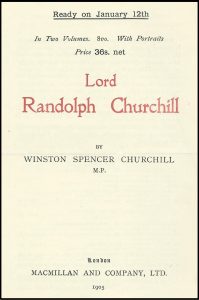 All this was as yet unseen when he won his first seat as a Liberal in North-West Manchester on 13 January 1906. Nonetheless, we can reasonably speculate that the importance of the victory was not lost upon Churchill. Churchill’s biography of his father had helped place Lord Randolph in historical context. We can also speculate that Churchill’s electoral victory as a Liberal in North-West Manchester helped Churchill put the specter of Lord Randolph’s failed political career behind him. Perhaps all of this was in Churchill’s mind – or perhaps he was simply grateful – when he paused to warmly inscribe this first edition of his newly published book to the man who helped him achieve success. Irrespective, this presentation set testifies to the remarkable convergences of a pivotal moment in the life of both ascending Winstons – the literary and the political.
All this was as yet unseen when he won his first seat as a Liberal in North-West Manchester on 13 January 1906. Nonetheless, we can reasonably speculate that the importance of the victory was not lost upon Churchill. Churchill’s biography of his father had helped place Lord Randolph in historical context. We can also speculate that Churchill’s electoral victory as a Liberal in North-West Manchester helped Churchill put the specter of Lord Randolph’s failed political career behind him. Perhaps all of this was in Churchill’s mind – or perhaps he was simply grateful – when he paused to warmly inscribe this first edition of his newly published book to the man who helped him achieve success. Irrespective, this presentation set testifies to the remarkable convergences of a pivotal moment in the life of both ascending Winstons – the literary and the political.